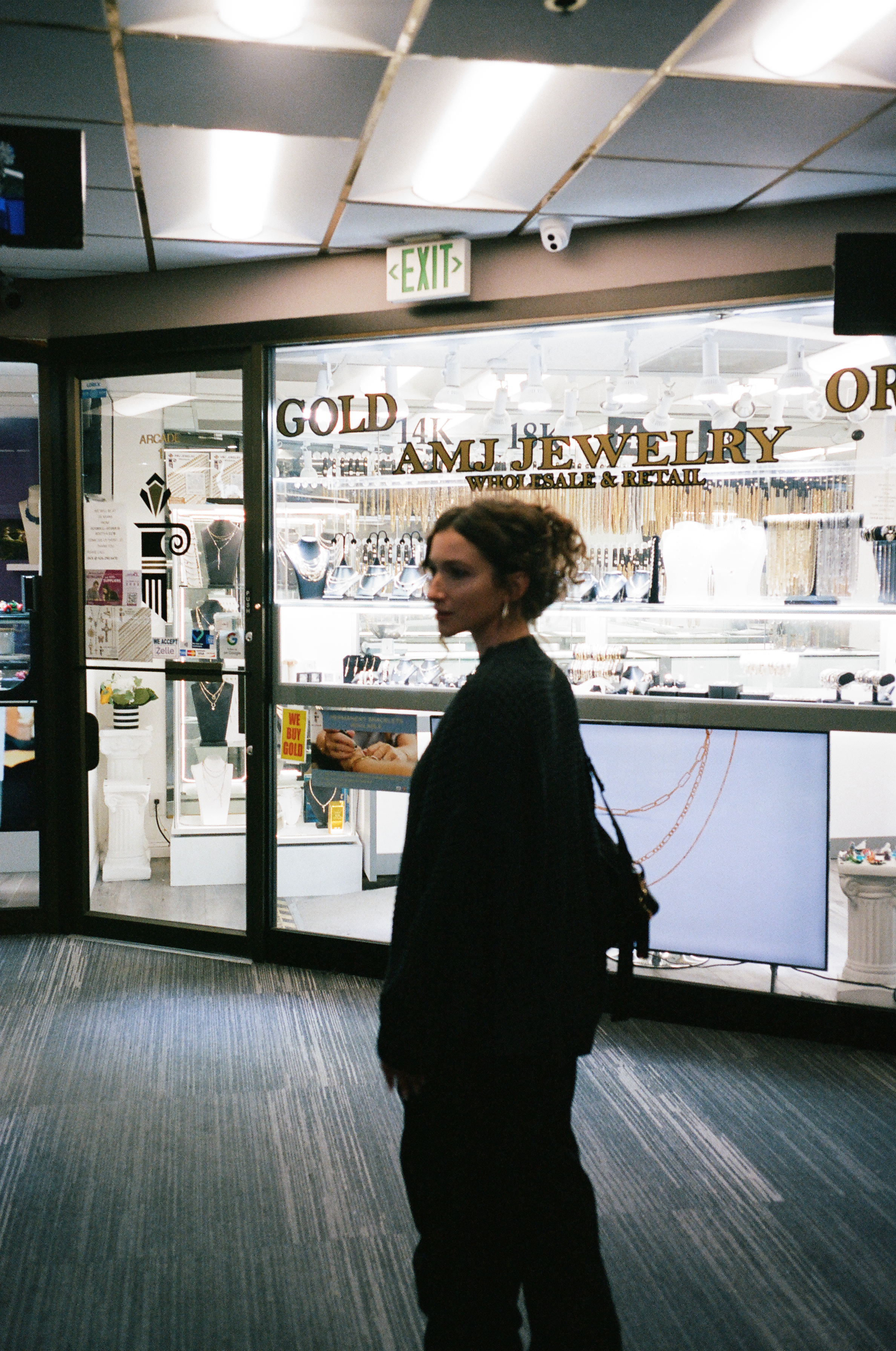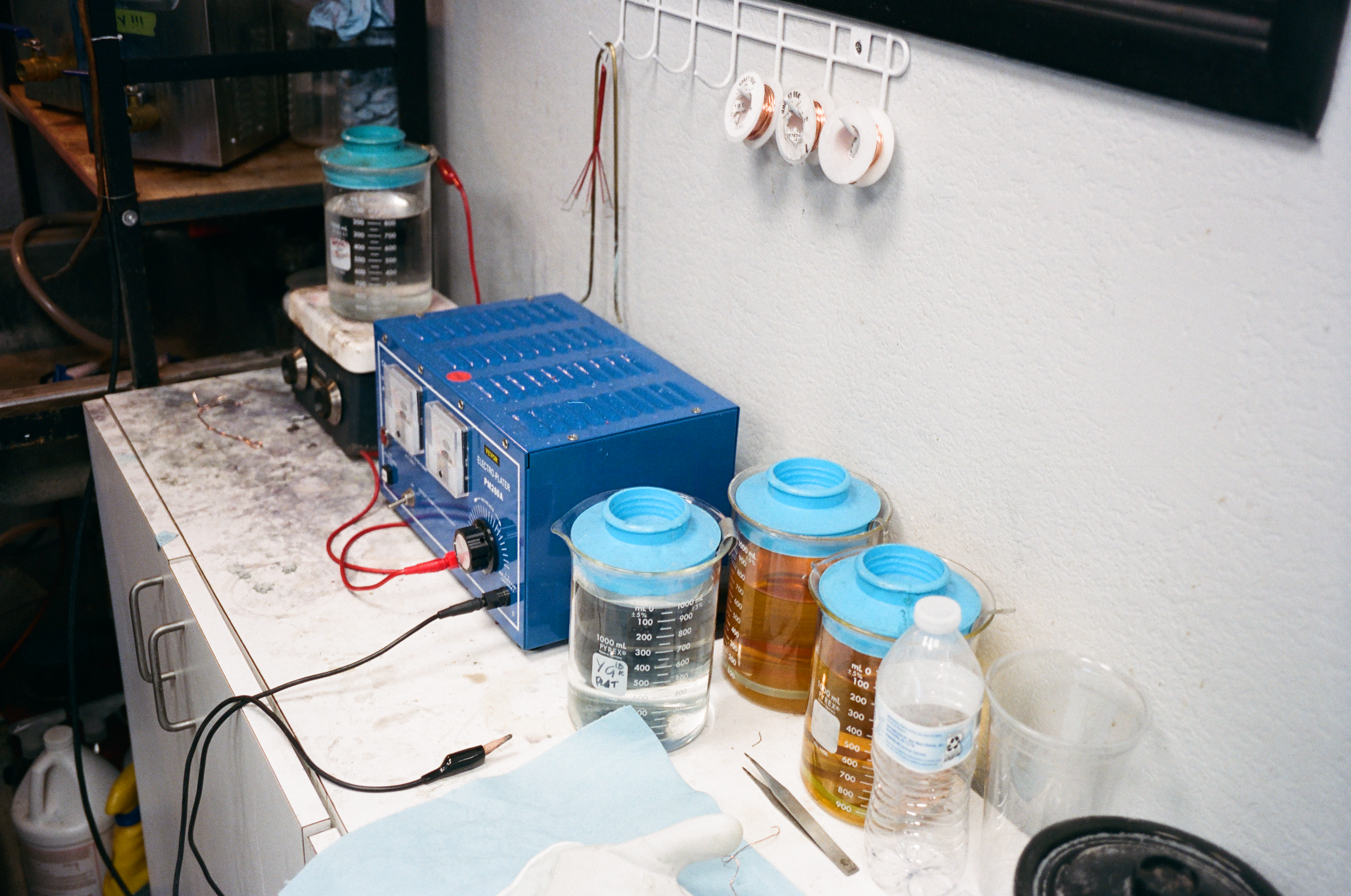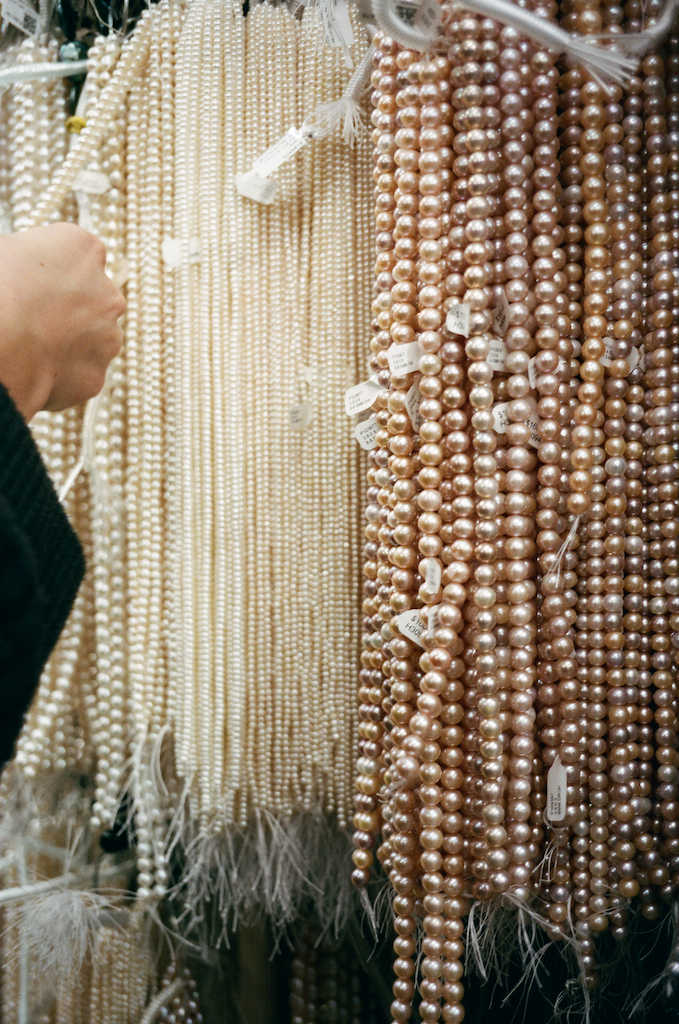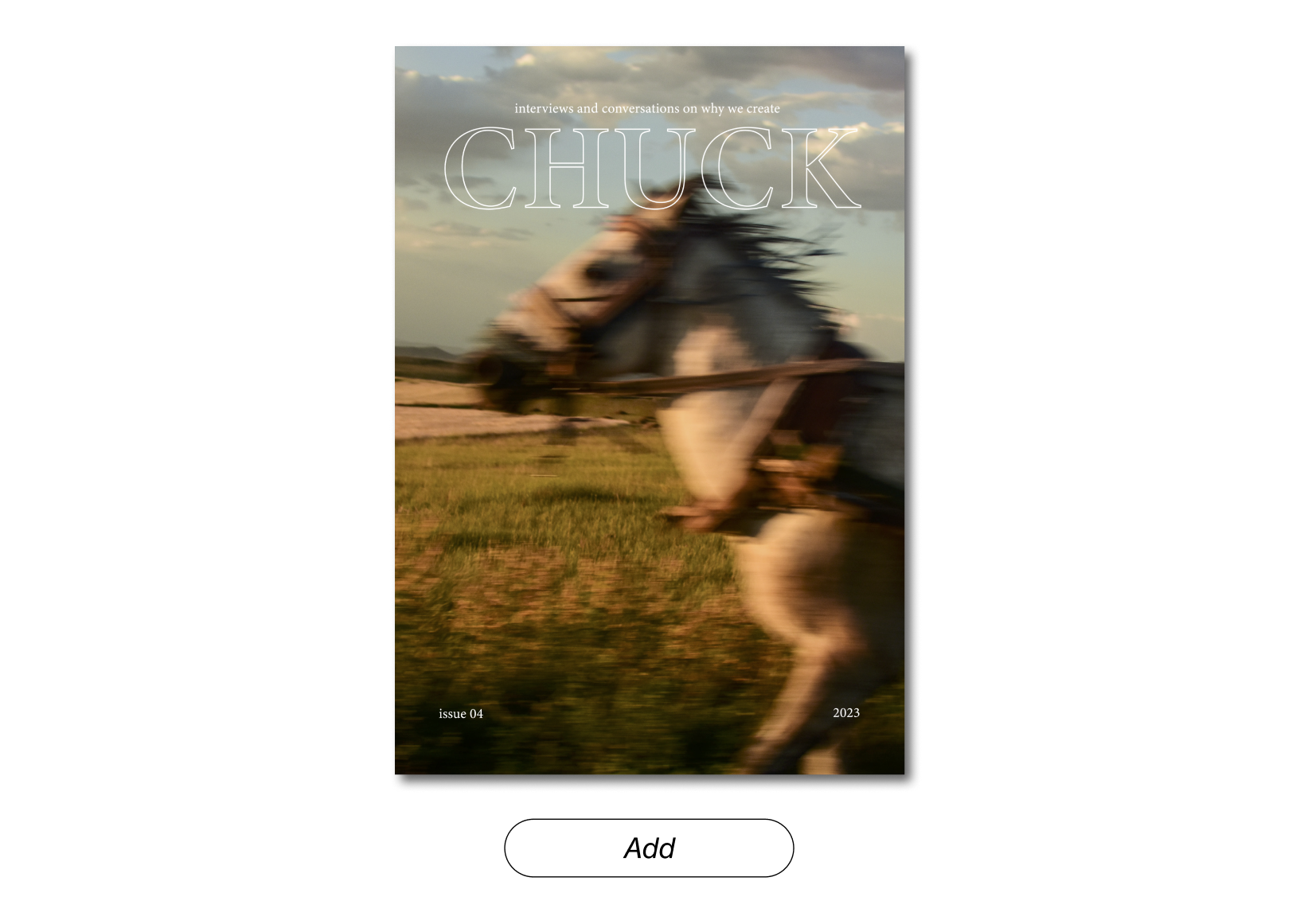

Rose Costolo
Rose Costolo is a Los Angeles based jewelry designer who balances beautiful designs with modern ethical precious metal and stone sourcing. Looking at Rose’s designs one would assume a team of industrial designers, gem specialists, and fabricators spent years crafting COSTOLO’s feminine jewelry, when in fact it is just Rose. While refining, reworking, and tirelessly finding the best sources and most reliable people, Rose pulls from everything around her to make something that will last forever. We spent a day with Rose in the Jewelry District of Downtown Los Angeles, walking in and out of studios, show rooms, and buying markets. COSTOLO is an endeavor set out to bridge relationships between people and fine jewelry – signifying love, celebration, and resulting in pieces meant to last a lifetime.
interview & photography by
Achilleas Ambatzidis & Finley Jacobsen
Achilleas Ambatzidis & Finley Jacobsen

We’ve interviewed many painters and musicians and a whole roster of different mediums, but we haven’t really delved into the world of fabricating, so to begin, how did you initially come to jewelry? What was it that interested you?
For me, it was really about the attraction to the 3D art form and quickly identifying that there was a way to make it a business. I realized after school that I didn’t know what I wanted to do, but it had to be social and on my feet. I was in this job that just wasn’t that. So I got curious, and it was very organic how I found myself in downtown, found amazing mentors, and fell in love with the process. I was obsessed with the details of how it all got done. It’s interesting, because some of the best jewelers have been architects before, this fascination with the 3D form, all the different mediums that you can apply it to.
What was it about that job you had before, that you knew wasn’t working?
I had a tech startup job that was working on solar energy and how to get energy into homes faster. It was interesting and I thought that I wanted to go into that line of work.
I just very quickly realized that sitting at home looking at a desk, I had nothing to do with the company, it was just so wrong in my bones.
What was that process of entering the jewelry world with these mentors?
I essentially asked if I could work for them for free as an intern. That worked out, so then I was coming in more than part time. It was very slow and organic, because everything is so small. To me the most important thing is to study whoever’s doing what you want to do well.
In terms of the realm of fabricators, jewelry is so coveted because you’re working with such precious metals. It’s also an incredibly complicated process to make something that someone will wear on their body. Can you tell us a little about this?
It’s so interesting, because it’s a physical currency, so as much as it is this coveted piece of fashion accessory. Gold is compared to the U.S. dollar everyday. But it comes down to who is your target audience and the different things people are looking for. There are two sides of my business. There’s custom one on one, like engagement rings. That is super hands on and social, talking to the fiance, “What stone should we do? How do we source it?” And the other side is pieces I’ve designed. I’m trying to be as original as possible, because I don’t want to make anything I’ve already seen out there. Both sides have the steps of imagining the pieces and then sourcing metalsmiths, etcetera.
How do you find those people, the metalsmith, the stone setter, and who are these people? Are they just hiding downtown?


Some of the craziest engineers that exist, honestly, are these amazing people from all over the world who have for whatever reason found a path in some aspect of the production process and have ended up in downtown LA doing this. Truly, the biggest thing I got out of working for the people I used to work for downtown was I met all of their relationships and resources. With their blessing I’m able to still go to those same freelancers. You work for yourself, and then you go to different people who do freelance engineering, say, this guy’s the best diamond setter or this person is really good with emeralds. I’ve had the most amazing stories of people’s backgrounds, this one guy used to engineer for the Armenian army, and is the most phenomenal metalsmith with prong setting. It’s so international. You hear different languages all day long, you’re never bored.
When did COSTOLO Jewelry fully form?
I started developing it and planning it six months before we launched. But it’s been launched for a year.
You have a serious amount of pieces that you’ve put out in this past year, what is the process or thinking of putting out that much work in such a short time?
I want everything to be unique; I want there to be as much as there can be for gold and diamonds in terms of various price ranges. It’s all luxury. But hopefully you can hit a few different ranges in price that still have a similar aesthetic. A piece can look great in theory, but then when you put it on the human body, it doesn’t feel good. I want to make sure that what feels good on this neck will feel good on someone else’s neck. When it’s diamond specifically, because it’s an intense material. I think the biggest breakthrough is making sure that since everything is a statement piece – its own thing – I’m not doing really small sets.
They should all feel good on the body looking great and feeling good: that’s my quality control.
Looking great and feeling good. What about working intimately with clients, you mentioned before engagement rings, how do you form those relationships of trust, because it’s a very personal thing.
Yeah, absolutely. It’s funny, because custom stuff is always going to be customer service – whether it goes so perfectly according to plan, the client and you vibe from the start, you have a great vision – you’re still doing a certain level of customer service. It comes down to constant communication about the expectations if it’s a multi-month long project. The biggest realization I’ve had is that a very small percentage of the population actually purchases fine jewelry online. It’s something that people still really like to see in person. The times when we’ve had the most success on sales are in showrooms, and we’ve done a couple other small pop up moments. For me, I’m pretty determined to figure out e-comm because it’s so much more streamlined, looking for virtual reality plugins or AR. I want to build something that exists still in 30 years.

Where do you look for inspiration or reference? Are you looking at jewelry from the 20s, or the 70s? Are you looking at the shape of a conch shell on the beach, or certain films?
Absolutely. All of the above. I’m learning more and more, and what I believe is that we’re all vessels. What you channel is how certain ideas appear and they’ll come up anytime. But when I’m looking for inspiration, I’m looking at nature. Because as a woman, the best conversations I have are about the jewelry we’ve loved from our past – jewelry our mom’s gave us. There’s something about it that feels like it has movement. Where do we find those things? I believe mostly in nature. If I’m always pulling from as unique places as possible, there’s no chance I’m subconsciously going to recreate things that exist. Just because there’s so much copy-paste jewelry and I’m terrified to be the kind of company that does that. I’ve had to do serious legal work to make sure I protect myself from that happening to me. So I want to make sure I’m pulling from authentic places, nature helps me maintain that.
What have been some stand out pieces for you, breakthrough works?
The MOLECULE ring, I always say that ring. It was so special that it came together and I was so happy the first day I tried it on. I feel like it resonates with people and I love that about it. I did some cool work with this nail artists last year, and we made some really unique pieces, as well as the teardrop earring we did.
What’s your thoughts in terms of sourcing with how you get diamonds or gold?
It was the biggest internal crisis I had when I first fell in love with this industry. Because I felt that I was falling in love with something that’s not only at the heart of ethical scrutiny, but being from the Bay Area or California, people are so aware of the environment. How am I going to work in something that’s having a detrimental effect? It was an internal conversation and I’ve found a couple of ways that I’ve made peace with it. I offer both, I have the best quality lab-grown diamonds, and I can make any engagement ring with those. That’s what I push for, if people aren’t interested in that, I can also source the most beautiful, clean as I can source, natural diamond from a mine that I have a relationship with. This is the best of my ability in terms of sourcing something natural. I’m not going to miss out on that customer because I don’t offer it, because I can. It’s not perfect, but the difference about us trying to enter this market at this level is that we offer both. The other things to consider are, if I’m working with lab-grown diamonds, a lot of lab-grown diamonds take up a ton of energy like the blockchain. Is that transaction even better? We’re doing it with wind farms from places that we source on the West Coast and do that only. Trying to always think through every step of where this material is coming from.

Can you tell the difference when you’re handling a lab-grown diamond vs. a real diamond?
No, and most diamond testers can’t tell anymore. But that’s because the technology is finally at that place. Even in the last couple of years, it’s gotten exponentially better.
Has that fucked up the diamond market?
You would think that it would, and the biggest real diamond company, De Beers – which is known to be gnarly from the early days in terms of ethical scrutiny – will always have enough money to flood the market with bad, ugly little sister marketing about lab-grown diamonds. Because finally, it’s a customer decision. Finally, there’s a demand, so how do they make it less valuable? The only thing that does make diamonds more valuable than lab-grown right now is the rarity factor. We can make one of these versus there’s only this much of it. But it doesn’t matter to who it doesn’t matter to. All I can do is keep presenting the opportunity for clients to look at it as valuable, they’re gonna have their own thoughts.
Is there a medium or form of work that you’re looking over the fence at and wanting to experiment or try? Anything that’s piquing your curiosity at the moment?
Honestly, there’s so many things. I would love to do crazy fashion pieces for campaigns that are over the top, sample pieces that we wouldn’t actually sell, but take it to that kind of level, that would be epic. I’m lucky because I can work with most materials because of the people I work with. I really want us to have a private showroom; that would be a secret location where people can come, look at and try things on. Stones are always crazy, finding a new stone, I just found this cool one blue zirconia, my little gem obsession.
What about the nuts and bolts of actually storing and keeping these insanely valuable objects and being safe about that?
In terms of production, everything’s in safes all day long, triple bolted doors, and the pieces aren’t even retail yet. So I don’t necessarily prioritize business insurance in that way. If I was someone selling at shows or selling in a storefront, it’s a really different conversation. We were talking for a while about opening up a store in Beverly Hills, and one of the biggest things was just dealing with your inventory changing, that’s the hard thing about brick and mortar, that is why e-comm is clean, you just have to have an image of the object.
I kind of like the idea of a Chinese restaurant or a flapjack spot in Beverly Hills and you open the side door and it’s COSTOLO, a secret little showroom.
That’s brilliant, I love that, that! We should do that in a James Bond movie.


Who are the jewelers or companies that you look at and are impressed by the work they’re doing and how they do it?
There’s this jeweler named Gaia Repossi, she took over her ancestor’s company, she is the creative director now. I think they’re doing some really cool modern stuff with fine jewelry, I love her design. She also is killing it internationally, she’s expanding into Asian markets, I think that’s really smart for what I’m trying to do and what she’s trying to do. Following that roadmap as much as I can. There’s a company called Shay Jewelry, which does a little less niche designs, but their volume is insane. They do a really great job with quality control and selling big ticket items online. Those two I really have my eye on. There’s also a company called Dorsey that’s doing lab-grown work that looks really high end. I’m loving their stuff.
Do you think at some point, lab-grown would be industry standard?
I would say so if we were looking at like one market, if we’re talking about the U.S. and our generation in the U.S. For us it’ll be standard. We are all this altruistic generation, we obviously are drawn to brands that follow our values. But if you’re talking about globally, no way. Because there’s always going to be people in different parts of the world who just are still raised with a certain standard of what luxury is and what a diamond is, it will just be laughed off for a long time.

It’s interesting that our generation, our culture has the potential to think in a way which could change the status quo, where our thinking could be, ‘Of course, everything should be lab-grown, it wouldn’t be good to wear something that is unethical.’ But there’s the rest of the world, outside the bubble. That thinking is, ‘No, I need something that is actually valuable.’
It’s true, different ages and different culture is exactly that. You have Frank Ocean’s company, Homer, they did beautiful, creative, super high ticket items. All lab-grown diamonds. For some people that’s working, it’s just not gonna work for everyone right now. Also not everyone is Frank Ocean, with that name attached. We just have to offer both, and hope that we’re doing a good enough job educating on why it’s the same.
Do you think the convention of an engagement ring or wedding ring having a “look at” diamond in it is changing?
It’s totally changing, because women are changing.
Women are more down for lab-grown diamonds, so then when their partner goes and is trying to buy an engagement ring for them, there’s tremendous pressure of buying this really expensive object. It’s at least a little bit resolved in their head because the person prefers an ethical diamond. You’re still spending money on a nice one, but you’re both comfortable with that. It’s do-able for younger ages to still have bigger sizes of rings, etc. But because the rarity of a natural one, it’s investment versus spending less upfront. If you wanted to trade a diamond in you would get money back for it and 20 years, but this lab-grown one, no one will give you a penny.
Which one would you prefer?
I kind of want a sick ruby instead of diamonds. I think by then we’ll be able to do color stones, lab-grown, much better than we can right now. That’d be a crazy, unique stone, something red. Definitely putting a man in a difficult position. I’m the jeweler. (Laughing)
Objects and jewelry especially have such a connection to the past, picking up your grandmother’s ring, a belt from my father, were there any family heirlooms that resonated with you when you were younger and now being on the other side, the creator side?
My mom had designed jewelry when I was younger. She would design and find artisans abroad who could help her produce things. One of the necklaces she did was so cool and unique and I have that. She gave her first one to me when I was graduating college. That’s why they’re important, right? And really the other true pillar that made me fall in love with this work, especially when I’m doing custom, is the fact that you’re always talking about and dealing with love. Whether it’s directly or indirectly, familial or someone’s just reached a certain milestone. There’s always love and meaning involved, especially when you’re trying to engrave or have something be for a person. It’s a very intimate thing to create something start to finish and it’s the most special part about it. Because a lot of times working in jewelry, it’s this glam filled industry about market price and whatever that means. Then there are moments where you’re just talking about people’s love and creating a symbol of love.

GRAB THE FOURTH ISSUE

More From Issue Four





